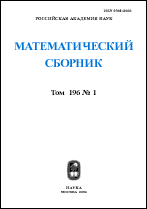|
This article is cited in 2 scientific papers (total in 2 papers)
Spline trigonometric bases and their properties
N. A. Strelkov
P. G. Demidov Yaroslavl State University
Abstract:
A family of pairs of biorthonormal systems is constructed such that for each $p\in(1,\infty)$ one of these systems is a basis in the space $L_p(a,b)$, while the other is the dual basis in $L_q(a,b)$ (here $1/p+1/q=1$). The functions in the first system are products of trigonometric and algebraic polynomials; the functions in the second are products of trigonometric polynomials and the derivatives of $B$-splines. The asymptotic behaviour of the Lebesgue functions of the constructed systems is investigated. In particular, it is shown that the dominant terms of pointwise asymptotic expansions for the Lebesgue functions have everywhere (except at certain singular points) the form $4/\pi^2\ln n$ (that is, the same as in the case of an orthonormal
trigonometric system). Interpolation representations with multiple nodes for entire functions of exponential type $\sigma$ are obtained. These formulae involve a uniform grid; however, by contrast with Kotel'nikov's theorem, where the mesh of the grid is $\pi/\sigma$ and decreases as the type of the entire function increases, in the representations obtained the nodes of interpolation can be kept independent of $\sigma$, and their multiplicity increases as the type of the interpolated function increases. One possible application of such representations (particularly, their multidimensional analogues) is an effective construction of asymptotically optimal approximation methods by means of scaling and argument shifts of a fixed function (wavelets, grid projection methods, and so on).
Received: 13.03.2000
Citation:
N. A. Strelkov, “Spline trigonometric bases and their properties”, Sb. Math., 192:7 (2001), 1053–1088
Linking options:
https://www.mathnet.ru/eng/sm583https://doi.org/10.1070/SM2001v192n07ABEH000583 https://www.mathnet.ru/eng/sm/v192/i7/p125
|


|




 Contact us:
Contact us: Terms of Use
Terms of Use
 Registration to the website
Registration to the website Logotypes
Logotypes







 Citation in format
Citation in format 
